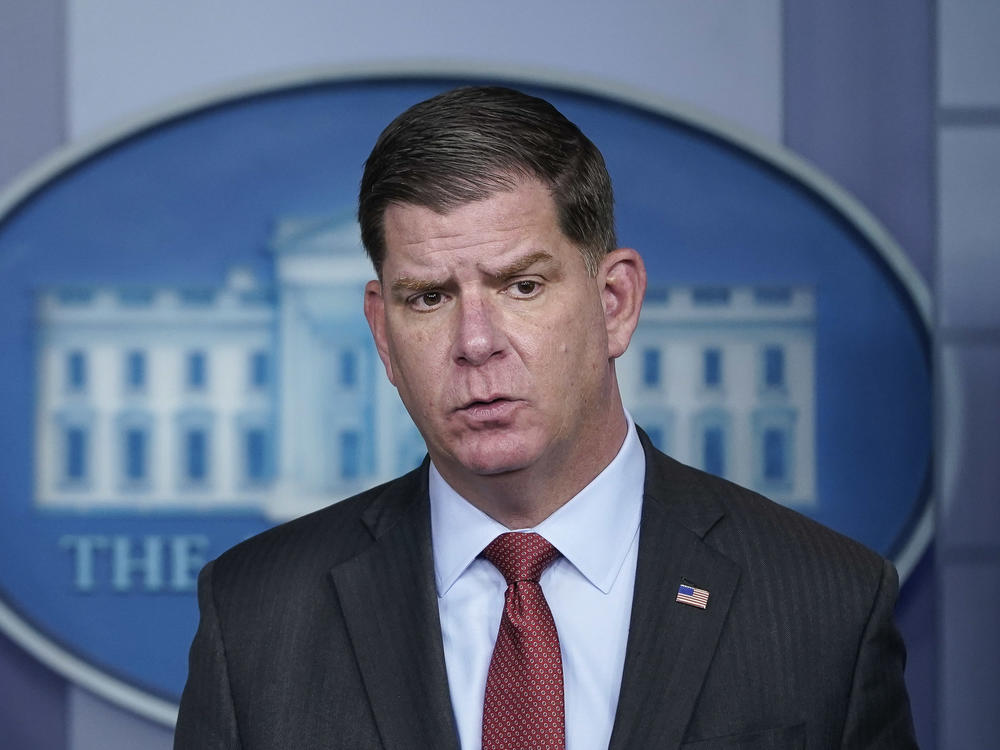Section Branding
Header Content
Getting Women Back To Work Is Key To A Strong Recovery, Labor Secretary Says
Primary Content
The road to full economic recovery from the pandemic may be steeper than anticipated.
U.S. employers added 266,000 jobs last month, the Labor Department reported Friday. That's far fewer than the nearly 1 million analysts expected given other recent signs of recovery: business reopening, consumer spending increasing, and new unemployment claims falling.
"Our economy is definitely recovering, but there are still millions of people in economic pain," Labor Secretary Marty Walsh said in an interview with All Things Considered. "We still have issues around child care. We still have issues around vaccines. We still have issues around people getting the virus. So we still have a ways to go here."
Child care problems and many kids still learning from home in part led millions of women to leave the workforce during the pandemic. Walsh said that's a big concern for the Biden administration. The president's proposed American Families Plan includes $225 billion for child care.
"We need to make sure if we're going to have a strong recovery — a strong, equitable recovery — we need to get women back into the workforce," Walsh said.
Following are highlights of the interview, edited for length and clarity.
On April's weaker-than-expected jobs numbers
Under normal circumstances, adding 266,000 jobs to the economy is a good number, but obviously we're not in normal times. We're definitely seeing the economy go in the right direction, but we still have a steep hill to climb. If you look at over the last three months, however, we've averaged over 500,000 jobs on average over the last three months, so we've added 1.5 million jobs. That shows good gain there as compared to the previous three months.
On what's holding employers back from adding more jobs
There's no question about it. People are still recovering from the pandemic. There are still concerns as far as businesses. ... There's a bunch of bright sides of this report, but one of them was that we saw the leisure and hospitality industry grew immensely, and that includes restaurants. We also saw more people in the month of April looking for employment than the previous months. But we're still in the midst of a pandemic.
On whether he's concerned that this could be a jobless recovery
No, I don't believe that. People are going to go back to work and people are going to get back to work. ... The president has made it very clear with the American Rescue Plan about strengthening and getting this economy moving forward. ... We are definitely moving in the right direction. Hospitality is opening in the different areas. We saw an increase in retail as well — in-person retail. But there's still lots of lots of people still working from home or looking for employment.
On whether unemployment benefits discourage people from looking for work
You know, I don't like when people talk about generous unemployment benefits because unemployment benefits are there to help people in very difficult, bad times. And many, many Americans have gone through very difficult, bad times for the last year. I think what we're seeing is that there are still major barriers to getting people back into the workforce ... lack of child care, also schools, you know, hybrid learning — in-person learning and online learning. People worried about the virus, people [worried] about getting vaccinated, people that are caretakers. So there's still barriers there. I'm not saying that's the whole excuse. ... People want to be back in the workplace. People want to be back working. ... With unemployment benefits, you don't get health care. You don't build your pension up. You don't build all of those programs that you need to move forward.
On helping women get back into the workforce
A couple weeks ago, the president and the White House released $30 billion ... to deal with that specific issue of child care. And it's about making investments in the child care facilities around our country. And that money is getting out around the country right now. So that's one one aspect. ... We need to make sure if we're going to have a strong recovery — a strong, equitable recovery — we need to get women back into the workforce.
And that's something that the president is focused on. That's something that I'm focused on here at the Department of Labor, as well as our unemployment numbers in the Black community. Today it is 9.7%. So our communities of color have higher unemployment rates than their white counterparts. ... We've always seen that discrepancy going back generations. But we have to be really intentional about investments that we're making to make sure that as we recover from the pandemic, it's an equitable recovery for all — for women and for people of color.
Copyright 2021 NPR. To see more, visit https://www.npr.org.

